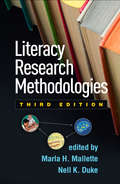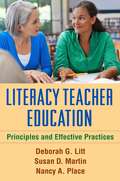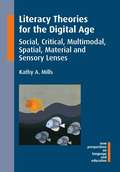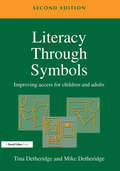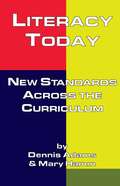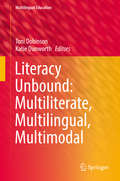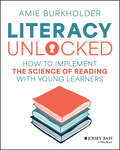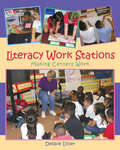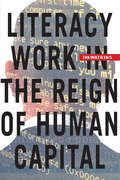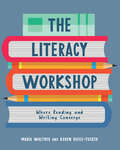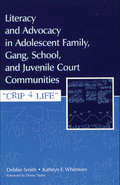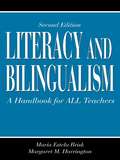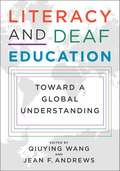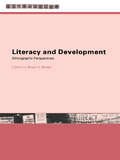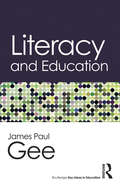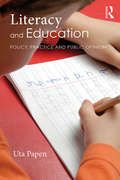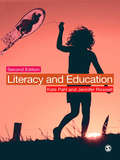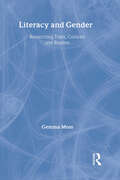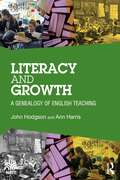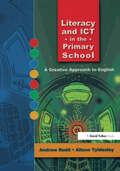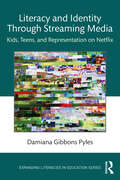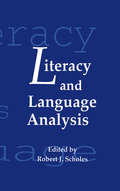- Table View
- List View
Literacy Research Methodologies, Third Edition
by Marla H. Mallette and Nell K. DukeDifferent research methods can yield unique insights into literacy learning and teaching--and, used synergistically, can work together to move the field forward. Now revised and updated with 50% new material, this definitive text presents widely used methods and provides students and researchers with a clear understanding of when, how, and why they are applied. Leading authorities describe established and emerging methodologies, review the types of questions they are suited to address, and identify standards for quality. Key issues in research design are accessibly discussed. Each chapter offers one or more exemplars of high-quality published studies to illustrate the approach in action. The benefits of using multiple types of methods to more fully investigate a given question or problem are emphasized throughout. New to This Edition *Chapter on a vital new topic: critical race methodologies. *New chapters on core topics: design-based research, causal effects, ethnographic case studies, correlational designs, discourse analysis, instrument development, and verbal protocols. *Up-to-date coverage of online research methods, neuroimaging, and other rapidly evolving methodologies. *Many of the exemplary studies are new.
Literacy Teacher Education
by Deborah G. Litt Susan D. Martin Nancy A. PlaceFew resources exist to give literacy teacher educators a comprehensive view of effective, innovative practices in their field, making this uniquely practical volume an important addition to the literature. Each chapter describes research findings and pedagogical methods, with an emphasis on what teachers really need to know to succeed. Woven into the text are more than 30 detailed activities and assignments to support teacher development, written by outstanding teacher educators. Links to professional teaching standards and the Common Core State Standards are highlighted throughout. Supplemental materials, including forms, checklists, and handouts, can be downloaded and printed in a convenient 8 1/2" x 11" size.
Literacy Teaching and Learning in Rural Communities: Problematizing Stereotypes, Challenging Myths
by Janet Alsup Lisa Schade EckertThis definitive look at teaching English in rural secondary schools contests current definitions and discussions of rural education, examines their ideological and cultural foundations, and presents an alternative perspective that conceptualizes rural communities as diverse, unique, and conducive to pedagogical and personal growth in teaching and learning. Authentic narratives document individual teachers’ moments of struggle and success in learning to understand, value, and incorporate rural literacies and sensibilities into their curricula. The teachers‘ stories and the scholarly analysis of issues raised through them illuminate the unique challenges and rewards of teaching English in a rural school and offer helpful insights and knowledge for navigating the pedagogical landscape.
Literacy Theories for the Digital Age
by Kathy A. MillsLiteracy Theories for the Digital Age insightfully brings together six essential approaches to literacy research and educational practice. The book provides powerful and accessible theories for readers, including Socio-cultural, Critical, Multimodal, Socio-spatial, Socio-material and Sensory Literacies. The brand new Sensory Literacies approach is an original and visionary contribution to the field, coupled with a provocative foreword from leading sensory anthropologist David Howes. This dynamic collection explores a legacy of literacy research while showing the relationships between each paradigm, highlighting their complementarity and distinctions. This highly relevant compendium will inspire researchers and teachers to explore new frontiers of thought and practice in times of diversity and technological change.
Literacy Through Symbols: Improving Access for Children and Adults
by Tina Detheridge Mike DetheridgeThis second edition of an important and essentially practical book is now fully updated and revised to take into account the significant developments that have been made in using symbols to support literacy. It is full of ideas and examples of the ways in which access to literacy can be enhanced through the use of symbols, based on the experience of the authors and many practitioners. Topics covered include how symbols are being used in schools, colleges and day care centers; ways in which symbols can help to enhance learning and independence; lots of new examples of good practice from practitioners; the results of the Rebus Symbol development project; how symbols fit in with the National Literacy Strategy; and how symbols can be used to make information more accessible. Teachers in mainstream and special schools, teaching assistants, day-care workers and parents should find this book helps them understand how to use symbols to improve literacy and aid communication.
Literacy Today: New Standards Across the Curriculum (Source Books on Education)
by Mary Hamm Dennis AdamsFirst Published in 2000. Routledge is an imprint of Taylor & Francis, an informa company.
Literacy Unbound: Multiliterate, Multilingual, Multimodal (Multilingual Education #30)
by Katie Dunworth Toni DobinsonThis volume promotes a thought-provoking discussion on contemporary issues surrounding the teaching of language and literacy based on first hand experiences and research. Drawing on the authors’ experiences as teacher educators, language and literacy teachers, and researchers on literacy issues it brings together the multiple traditions. What makes the proposed volume unique is the common theme that runs through all the chapters: the examination of the term literacy, the complexity of this term and the importance of having a wide understanding of what it is before tackling educational issues of pedagogy, assessment and student engagement. What is more, as the editors argue, it is necessary to join up the dots and explore the commonalities that form the core of the literacy spectrum.
Literacy Unlocked: How to Implement the Science of Reading with Young Learners
by Amie BurkholderThe latest research and most effective teaching tools for better early literacy instruction Literacy Unlocked explores the pivotal role of early literacy instruction in shaping a child's reading development and overall academic success. Shifting the focus from reactive intervention to a proactive approach that addresses problems before they arise, this book equips readers with research-backed insights and practical, accessible strategies to implement the science of reading to ensure future generations excel in literacy. Each chapter includes a link leading readers to supplementary online materials that can be utilized in instruction. Written by Amie Burkholder, K-5 literacy coach and CEO of Literacy Edventures, a popular early literacy learning platform, this book explores ideas including: The brain science of reading, with information on brain plasticity and the roles of the frontal, occipital-temporal, and parietal-temporal regions The disconnect in learning phonemic awareness and phonics separately, and why and how to address it as instructors Prerequisites for effective handwriting instruction, such as fine motor skills, pencil grip and posture, and understanding writing lines The importance of predictable routines in literacy instruction to help alleviate excessive student cognitive load, including the use of decodable texts Cutting to the crux of better literacy instruction in simple language that anyone can understand, Literacy Unlocked is an essential resource for K-5 teachers, administrators, instructional assistants, reading specialists, and literacy coaches.
Literacy Work Stations: Making Centers Work
by Debbie DillerEver wonder what the rest of your class should be doing while you are working with a small reading group? Debbie Diller offers practical suggestions in Literacy Work Stations: Making Centers Work for over a dozen literacy work stations that link to classroom instruction and make preparation and management easy for teachers. Learn how to set up work stations, how to manage them, and how to keep them going throughout the year. Each chapter includes: How to introduce each station Which materials to include at which station What to model the station as How to solve problems and differentiate How to assess while keeping students accountable Reflection questions for professional development Materials in both English and Spanish are provided in the extensive resource section. Throughout the book the author has included photos of literacy workstations from a variety of classrooms in which she has worked to illustrate the methods discussed in the text. Literacy Work Stations is a go-to classroom resource that will help you keep all students engaged while you focus in on small groups.
Literacy Work in the Reign of Human Capital
by Evan WatkinsIn recent years, a number of books in the field of literacy research have addressed the experiences of literacy users or the multiple processes of learning literacy skills in a rapidly changing technological environment. In contrast to these studies, this book addresses the subjects of literacy. In other words, it is about how literacy workers are subjected to the relations between new forms of labor and the concept of human capital as a dominant economic structure in the United States. It is about how literacies become forms of value producing labor in everyday life both within and beyond the workplace itself.As Evan Watkins shows, apprehending the meaning of literacy work requires an understanding of how literacies have changed in relation to not only technology but also to labor, capital, and economics. The emergence of new literacies has produced considerable debate over basic definitions as well as the complexities of gain and loss. At the same time, the visibility of these debates between advocates of old versus new literacies has obscured the development of more fundamental changes. Most significantly, Watkins argues, it is no longer possible to represent human capital solely as the kind of long-term resource that Gary Becker and other neoclassical economists have defined. Like corporate inventory and business management practices, human capital—labor—now also appears in a “just-in-time” form, as if a power of action on the occasion rather than a capital asset in reserve.Just-in-time human capital valorizes the expansion of choice, but it depends absolutely on the invisible literacy work consigned to the peripheries of concentrated human capital. In an economy wherein peoples’ attention begins to eclipse information as a primary commodity, a small number of choices appear with an immensely magnified intensity while most others disappear entirely. As Literacy Work in the Reign of Human Capital deftly illustrates, the concentration of human labor in the digital age reinforces and extends a class division of winners on the inside of technological innovation and losers everywhere else.
Literacy Workshop: Where Reading and Writing Converge
by Maria Walther Karen Biggs-TuckerThe Literacy Workshop: Where Reading and Writing Converge is a first-of-its-kind resource that offers a practical process for creating an integrated literacy workshop using demonstration lessons that align with current curriculum standards. In this forward-thinking book, authors Maria Walther and Karen Biggs-Tucker share what they've learned over countless reading and writing workshops and combine into one literacy workshop. The authors demonstrate how you can save valuable classroom time while still empowering students to uncover exciting connections in their learning – leading to stronger, more motivational readers and writers. By weaving the common threads of literacy learning together, you can increase the time your students spend engaged in authentic reading and writing. Inside you'll find the following: A clear, succinct explanation of the literacy workshop structure, how to get started, and how to determine the best time to begin the merge; 50+ demonstration lesson plans, appropriate for both primary and intermediate grade levels, that use strategies incorporating elements from recommended fiction and nonfiction anchor texts; Substantial, printable resources and online tools to help make this instructional shift as smooth as possible. From the big picture to small, helpful details, The Literacy Workshop will be your guide as you blur the lines between your reading and writing workshops - creating space for students to apply their learning and practice the habits, behaviors, and actions of literate and engaged citizens.
Literacy and Advocacy in Adolescent Family, Gang, School, and Juvenile Court Communities: Crip 4 Life
by Kathryn F. Whitmore Debra SmithThe goal of this book is to encourage educators and researchers to understand the complexities of adolescent gang members' lives in order to rethink their assumptions about these students in school. The particular objective is to situate four gang members as literate, caring students from loving families whose identities and literacy keep them on the margins of school. The research described in this book suggests that advocacy is a particularly effective form of critical ethnography. Smith and Whitmore argue that until schools, as communities of practice, enable children and adolescents to retain identities from the communities in which they are full community members, frightening numbers of students are destined to fail.The stories of four Mexican American male adolescents, who were active members of a gang and Smith's students in an alternative high school program, portray the complicated, multiple worlds in which these boys live. As sons and teenage parents they live in a family community; as CRIP members they live in a gang community; as "at risk" students, drop-outs, and graduates they live in a school community, and as a result of their illegal activities they live in the juvenile court community. The authors theorize about the boys' literacy in each of their communities. Literacy is viewed as ideological, related to power, and embedded in a sociocultural context. Vivid examples of conversation, art, tagging, rap, poetry, and other language and literacy events bring the narratives to life in figures and photographs in all the chapters. Readers will find this book engaging and readable, yet thought provoking and challenging.Audiences for Literacy and Advocacy in Adolescent Family, Gang, School, and Juvenile Court Communities include education researchers, professionals, and students in the areas of middle/high school education, at-risk adolescent psychology, and alternative community programs--specifically those interested in literacy education, sociocultural theory, and popular culture.
Literacy and Bilingualism: A Handbook for ALL Teachers (2nd Edition)
by Maria Estela Brisk Margaret M. HarringtonThis handbook applies proven techniques, derived from bilingual/bicultural classrooms, to teaching literacy in the twenty-first century. Its goal is to help teachers increase their understanding of bilingual learners in order to maximize instruction. Teachers can use this handbook to expand their understanding of literacy and bilingualism; implement literacy approaches and assess students’ development; and learn through reflection. Practical, flexible format and content. Complete and straightforward instructions, illustrated by case studies, allow teachers to use the strategies in this handbook on their own or in teacher-led study groups. They can select from the variety of approaches the ones which best match their students’ needs and their own teaching style. Student-centered focus. All of the approaches share characteristics that help motivate students of varying language abilities to develop literacy. Field-tested approaches. The approaches have been modified and tested with bilingual students of different ages and language backgrounds in bilingual, ESL, mainstream, special education, and deaf education classes ranging from preschool through high school. New in the Second Edition: *five new approaches with their corresponding classroom implementation;*additional information in each introduction addressing its theme;*new material on issues of language, culture, and literacy development of students completely new to the English language; and*annotated bibliographies with sample books to support literacy within language and content area classes. Literacy and Bilingualism is intended for a broad audience of teachers in any type of classroom where bilingualism plays a role, and is an excellent text for preservice and inservice courses that prepare teachers to work with English language learners.
Literacy and Deaf Education: Toward a Global Understanding
by Jean Andrews Qiuying WangInternational perspectives about literacy and deaf students is an uncharted intellectual landscape. Much of the literacy research in deaf education is conducted in English-speaking countries—primarily the United States—but 90% of deaf children live outside the U.S. and learn various signed and spoken languages, as well as diverse writing systems. Many of these children face significant educational challenges. In order to improve the literacy outcomes of deaf students around the world, it is imperative to study how children are using their local signed and spoken languages along with Deaf culture to learn to read and write. This volume fills a void in the field by providing a global view of recent theoretical and applied research on literacy education for deaf learners. Literacy and Deaf Education: Toward a Global Understanding is organized by region and country, with the first part discussing writing systems that use alphabetic scripts, and the second part focusing on countries that use non-alphabetic scripts. Some examples of the wide spectrum of topics covered include communication methodologies, curriculum, bilingual education, reading interventions, script diversity, and sociocultural development, including Deaf cultural developments. The contributors provide the results from literacy projects in fifteen countries and regions. This volume aims to widen the knowledge base, familiarize others in the field with these initiatives, and improve global understandings and outcomes of literacy teaching and learning in deaf education from birth to high school. Signed chapter summaries are available on the Gallaudet University Press YouTube channel.
Literacy and Development: Ethnographic Perspectives (Literacies)
by Brian V. StreetLiteracy and Development is a collection of case studies of literacy projects around the world.The contributors present their in-depth studies of everyday uses and meanings of literacy and of the literacy programmes that have been developed to enhance them. Arguing that ethnographic research can and should inform literacy policy in developing countries, the book extends current theory and itself contributes to policy making and programme building.A large cross-section of society is covered, with chapters on Women's literacy in Pakistan, Ghana, and Rural Mali, literacy in village Iran, and an 'Older Peoples' Literacy Project.This international collection includes case studies from: Peru, Pakistan, India, South Africa, Bangladesh, Mali, Nepal, Iran, Eritrea, Ghana.
Literacy and Education: Ideology In Discourses (Routledge Key Ideas in Education)
by James Paul GeeLiteracy and Education tells the story of how literacy—starting in the early 1980s—came to be seen not as a mental phenomenon, but as a social and cultural one. In this accessible introductory volume, acclaimed scholar James Paul Gee shows readers how literacy "left the mind and wandered out into the world." He traces the ways a sociocultural view of literacy melded with a social view of the mind and speaks to learning in and out of school in new and powerful ways. Gee concludes by showing how the very idea of "literacy" has broadened into new literacies with words, signs, and deeds in contexts enhanced, augmented, and transformed by new technologies.
Literacy and Education: Policy, Practice and Public Opinion
by Uta PapenLiteracy is a perennial ‘hot topic’ in Britain and other English-speaking countries. Concerns about falling standards and a ‘literacy crisis’ are frequently raised. In response, governments initiate new policies and teaching guidelines. This book addresses the current policies, practices and media debates in England, the US, Scotland and Australia. Literacy and Education examines: How literacy is taught to children in primary schools; The place of phonics in current policies and the arguments made for and against it; How teachers deliver phonics lessons and how children engage with the method; The range of literacy practices children engage with throughout the school day and how they contribute to literacy learning; The contributions a social and critical perspective on literacy can make to current debates regarding teaching strategies; A wide range of research conducted in the UK, North America, Australia and other countries. Bringing together policy, practice and public debate and drawing on the author’s extensive research in a primary school, this essential new textbook provides questions and tasks for readers to engage with. Literacy and Education is ideal for advanced undergraduate and postgraduate students of literacy and education and students on PGCE courses. It will also be of interest to researchers and teachers.
Literacy and Education: Understanding The New Literacy Studies In The Classroom (New Perspectives On Language And Education Ser. #4)
by Dr Kate Pahl Dr Jennifer RowsellLiteracy and Education continues to be an accessible guide to current theory on literacy with practical applications in the classroom. This new edition has a new focus on the ecologies of literacy and on participatory and visual ways of researching literacy. The new edition examines - new literacy studies - material culture and literacy - digital literacies - the ecological, place-based approaches to literacy education - timescales and identities, and - ways in which research has moved on to inform literacy education. Classroom teachers, teacher trainers and students of literacy will find this a user-friendly guide to new theory in literacy education, clearly demonstrating how to implement this theory in the classroom in a way that is inclusive and listens to the students of today.
Literacy and Gender: Researching Texts, Contexts and Readers (Literacies)
by Gemma MossWhy are girls outperforming boys in literacy skills in the Western education system today? To date, there have been few attempts to answer this question. Literacy and Gender sets out to redress this state of affairs by re-examining the social organization of literacy in primary schools. In studying schooling as a social process, this book focuses on the links between literacy, gender and attainment, the role school plays in producing social difference and the changing pattern of interest in this topic both within the feminist community and beyond. Gemma Moss argues that the reason for girls’ relative success in literacy lies in the structure of schooling and in particular the role the reading curriculum plays in constructing a hierarchy of learners in class. Using fine-grained ethnographic analysis of reading in context, this book outlines methods for researching literacy as a social practice and understanding how different versions of what counts as literacy can be created in the same site.
Literacy and Globalization: Reading and Writing in Times of Social and Cultural Change (Routledge Research in Literacy)
by Uta PapenUsing literacy practices in the newly independent post-apartheid Namibia as a lens through which to examine the effects of globalisation, this broad case study looks at issues surrounding tourism, state control and the new forces of consumerism. By placing literacy at the centre of an investigation into social and cultural change as experienced by individuals, Papen shows that in times of change, reading and writing are always implicated in structures of power and inequality. The book considers language practices that can exclude some members of Namibian society and also looks at the strategies used by local people to accommodate and even embrace the onward march of global English and the influx of foreign visitors, practices and modes of commerce and interaction.
Literacy and Growth: A Genealogy of English Teaching (National Association for the Teaching of English (NATE))
by John Hodgson Ann HarrisLiteracy and Growth is a unique genealogical study of English teaching in the UK and abroad since the 18th century. Focusing specifically on the concepts of literacy and growth, this book explores key moments in the development of ideas about English teaching. Hodgson and Harris reveal the Enlightenment forebears of such contemporary concepts as “cultural capital” and “critical literacy”; the significance of “growth” to the writers and social critics who opposed Victorian Utilitarianism; and the 20th-century influences that established English as a humane study, including the Newbolt Report, the Cambridge Scrutiny group, and the London School of Percival Gurrey and James Britton. The authors examine unpublished Dartmouth Conference papers to reconsider John Dixon’s construction of “growth” in his seminal report Growth through English (1967). They reflect on the turbulent aftermath of Dartmouth, the changes in the “growth” model following the cultural turn in English studies, and the politics behind the shift from “English” to “literacy” in the 1990s. Importantly, they redefine the growth model for the 21st century to support teachers and students in the current context of performativity, high-stakes assessment, the “knowledge curriculum”, and artificial intelligence.Essential reading for tutors and students of English and literacy as well as policymakers in the subject area, this book will engage all those interested in the history and philosophy of English in education. It will be a key resource for those involved in the education and training of English teachers, as well as those undertaking research in English education.
Literacy and ICT in the Primary School: A Creative Approach to English
by Andrew RuddBy clearly outlining how ICT can enhance and improve children’s learning, this book unlocks the full potential of ICT within the classroom. Stimulating, useful and free of jargon, the book provides many practical examples to show teachers where, when and how ICT can be used effectively within literacy teaching. It provides advice on: teaching creatively using ICT in the Foundation Stage making the most of your resources planning and assessment. Rooted in the practical realities of the classroom, this book will support both trainee and qualified teachers in providing rich and creative literacy experiences through the use of technology.
Literacy and Identity Through Streaming Media: Kids, Teens, and Representation on Netflix (Expanding Literacies in Education)
by Damiana Gibbons PylesIn this book, Damiana Gibbons Pyles guides readers through the fast-changing landscape of digital streaming services such as Netflix and explores their impact on children’s and teens’ identities. Children interact with streaming media in novel, hidden, and unforeseen ways that shape their digital, material, affective, and embodied worlds. By analyzing how Netflix represents gender, race, and ethnicities, Gibbons Pyles explores how this new media phenomenon portrays and influences young people’s development and sense of self, and how streaming media pushes children and teens to particular ways of being in its interfaces, algorithms, and content. Drawing primarily on Bakhtinian, feminist, and female Black scholarship, her incisive analysis reveals how the new media streaming phenomenon molds children’s understandings of their ways of being in the world. Ideal for scholars and graduate students in literacy education, media studies, and communication, the text is an illuminating view into the hidden role of streaming services as an essential, complex component of literacy scholarship.
Literacy and Language Analysis
by Robert J. ScholesThis volume investigates the interconnections between language and literacy in terms of the structures of language as well as the linguistic contexts of literacy. The work for this book was generated in order to focus on studies of the acquisition and impact of literacy on traditional assertions of linguistic analysts. The contributors show that claims regarding descriptions of the linguistic competence of native speakers contain phonemic, morphemic, and sentential constructs applicable only to literate language users. They also suggest that syntactic formalities -- elements lacking extensional reference -- are unlikely in the absence of literacy, and that the notions of "sentencehood" and syntactic well-formedness are functions of literacy. Finally, the book reviews the basic notions of literary relativity and the role of literacy in communication and civilization.
